Related Research Articles

Southern Illinois University is a public research university in Carbondale, Illinois. Chartered in 1869, SIU is the oldest and flagship campus of the Southern Illinois University system. SIU enrolls students from all 50 states and more than 100 countries. Originally founded as a normal college, the university today provides programs in a variety of disciplines, combining a strong liberal arts tradition with a focus on research. SIU was granted limited university status in 1943 and began offering graduate degrees in 1950. A separate campus was established in Edwardsville, Illinois in 1957, eventually becoming Southern Illinois University Edwardsville.

Arthur John Cronquist was an American biologist, botanist and a specialist on Compositae. He is considered one of the most influential botanists of the 20th century, largely due to his formulation of the Cronquist system as well as being the primary co-author to the Flora of the Pacific Northwest, still the most up to date flora for three northwest U.S. States to date. Two plant genera in the aster family have been named in his honor. These are Cronquistia, a possible synonym of Carphochaete, and Cronquistianthus, which is sometimes included as a group within Eupatorium. The former was applied by R.M. King and the latter by him and Harold E. Robinson.
Allen Charles Skorepa was an American lichenologist, and a specialist on the lichens of Maryland.

Fountain Bluff is a large, isolated range of hills located in the floodplain of the Mississippi River, on the river's east bank in Fountain Bluff Township, Illinois. Its unusual geographic location was a result of glaciation during the previous Ice Age. It is known for its high steep sandstone cliffs along the river, its biodiversity and abundant Native American rock art.

Robert F. Thorne was an American botanist. He was taxonomist and curator emeritus at Rancho Santa Ana Botanic Garden and professor emeritus at Claremont Graduate University in Claremont, California. His research has contributed to the understanding of the evolution of flowering plants.

Scleranthus annuus is a species of flowering plant in the family Caryophyllaceae known by the common names German knotweed and annual knawel. It is native to Europe, Asia, and North Africa, and it is known throughout the rest of the temperate world as an introduced species and a common weed. It grows in many types of habitat, often in disturbed areas.

David Moresby Moore was a British botanist who wrote two reference works on Antarctic and sub-Antarctic flora, co-edited a book on Patagonian flora and wrote numerous other books on plant cytogenetics and global flora.

Iris prismatica, the slender blue flag or cubeseed iris, is a plant species native to parts of the southern and eastern United States from Maine south to Alabama, as well as to the Canadian provinces of Ontario and Nova Scotia.
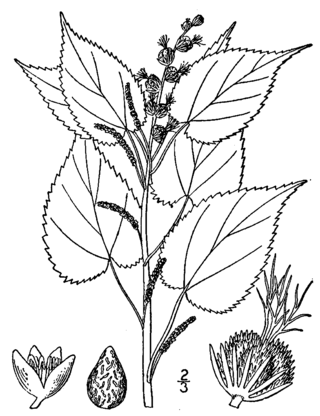
Acalypha ostryifolia, sometimes spelled ostryaefolia, is a plant in the family Euphorbiaceae and is commonly known as hophornbeam copperleaf, hornbeam copperleaf, or pineland threeseed mercury, is an annual herb of the copperleaf genus Acalypha. It is a native of North and Central America and is generally considered a weed.

Iris fulva, also known as copper iris, is a species in the genus Iris, it is also in the subgenus Limniris and in the series Hexagonae. It is a rhizomatous perennial, endemic to the southern and central United States. It has copper-red to deep red flowers and bright green leaves.

Stellaria aquatica is a species of flowering plant in the carnation family Caryophyllaceae, known as water chickweed or giant chickweed. It is a perennial herbaceous dicot plant with stems between 10 and 100 cm. high, growing in humid, wet areas, for example, on the sides of gutters or under or between bushes. It occurs naturally in the temperate regions of central and western Europe. The flowers are white. The plants bloom between June and August.

Vernonia baldwinii, commonly known as western ironweed or Baldwin's ironweed, is a perennial herb native to the central United States. It is in the Asteraceae (aster) family.
Gerould S. Wilhelm is an American botanist and lichenologist. He is known as author of several floras of the Chicago Region and the development of the Floristic Quality Assessment methodology, a tool to assess the integrity of natural areas. He is the director of research at Conservation Research Institute, a nonprofit organization "dedicated to the promotion of planning, design, restoration, and long-term management of sustainable ecological systems in built and natural environments through applied research, education, and outreach."
Floyd Allen Swink (1921-2000) was an American botanist, teacher of natural history, and author of several floras of the Chicago region.
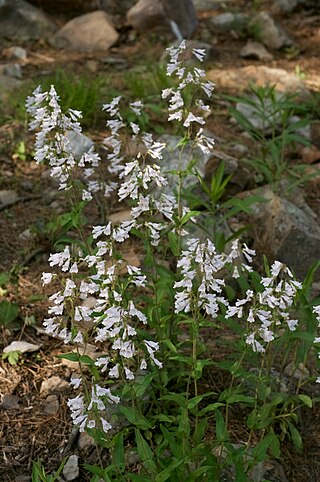
Penstemon arkansanus is a species of flowering plant in the plantain family known by the common name Arkansas beardtongue. It is endemic to Texas, Arkansas, Oklahoma, Missouri, and Illinois in the United States, occurring in rocky or sandy soils of shale or sandstone.
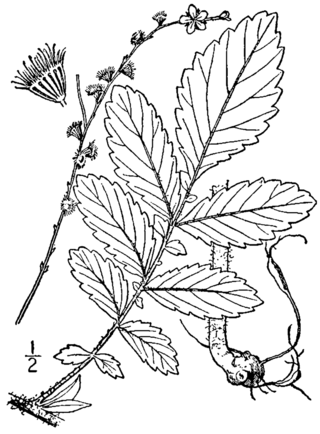
Agrimonia pubescens, the soft agrimony or downy agrimony, is a flowering plant in the genus Agrimonia, a member of the rose family. It grows in dry areas and woodlands.

Daniel Lee Nickrent is an American botanist, working in plant evolutionary biology, including the subdisciplines of genomics, phylogenetics, systematics, population genetics, and taxonomy. A major focus has been parasitic flowering plants, particularly of the sandalwood order (Santalales). His interest in photographic documentation and photographic databases has led to several photographic databases including Parasitic Plant Connection, Phytoimages, Plant Checklist for the Rocky Mountain National Park, and Plant Checklist for the Crab Orchard National Wildlife Refuge.
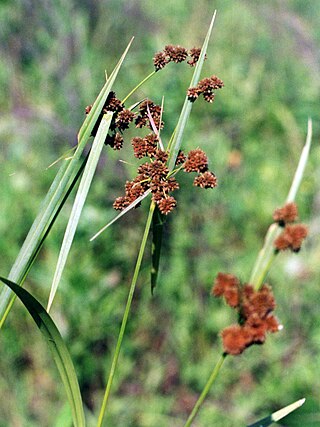
Scirpus atrovirens, known as dark-green bulrush, is a perennial sedge native to wetlands of eastern Canada and the United States. It is sometimes called dark green bulsedge, black bulrush, or green bulrush.

Carex muehlenbergii is a species of flowering plant, it is a type of sedge. It is a grass-like plant in the family Cyperaceae. Its common names include sand sedge, Muhlenberg's sedge.
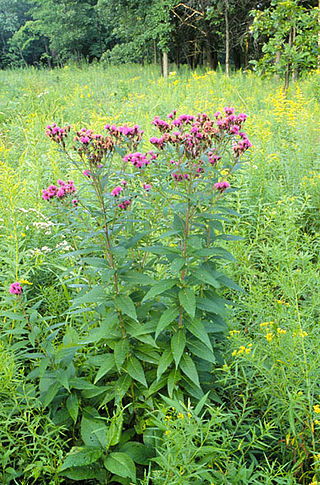
Vernonia fasciculata, the smooth ironweed or common ironweed, or prairie ironweed is a species of perennial plant in the family Asteraceae. It is native to Manitoba in Canada and the north-central U.S.A.
References
- 1 2 "Robert H. Mohlenbrock". plantbiology.siu.edu. Southern Illinois University Carbondale Department of Plant Biology. Retrieved February 23, 2018.
- 1 2 3 4 5 6 Fitzpatrick, Tony (1993). Signals from the Heartland. Walker & Company. ISBN 978-0-8027-1260-8.
- 1 2 Weber, Wallace R. (1990). "Robert H. Mohlenbrock: His Botanical Roots and His Influence on Missouri Botany" (PDF). Missouriensis. 11 (1): 10–16.
- ↑ "Graduate Students Chronologically". plantbiology.siu.edu. Southern Illinois University Carbondale Department of Plant Biology. Retrieved February 23, 2018.
- ↑ Lewis, Walter H. (1965). "Graduate Students of Robert E. Woodson, Jr". Annals of the Missouri Botanical Garden. 52 (3): 248–350. doi:10.2307/2394790. JSTOR 2394790.
- ↑ "The Origin of Flora of the Chicago Region: A Floristic and Ecological Synthesis". conservationresearchinstitute.org. Conservation Research Institute. March 2017. Retrieved February 23, 2018.
- ↑ Mohlenbrock, Robert H. (May 2009). "On Heron Pond: Illinois dips its toe in a southern swamp". Natural History. New York: The American Museum of Natural History. Retrieved February 23, 2018.
- 1 2 "Curriculum Vitae of Robert H. Mohlenbrock" (PDF). plantbiology.siu.edu. Southern Illinois University Carbondale Department of Plant Biology. Retrieved February 23, 2018.
- ↑ "Erigenia No. 1" (PDF). Erigenia. 1: 1. 1982.
- ↑ "Illinois Native Plant Society – About Us". ill-inps.org. Illinois Native Plant Society. Retrieved February 23, 2018.
- ↑ International Plant Names Index. Mohlenbr.